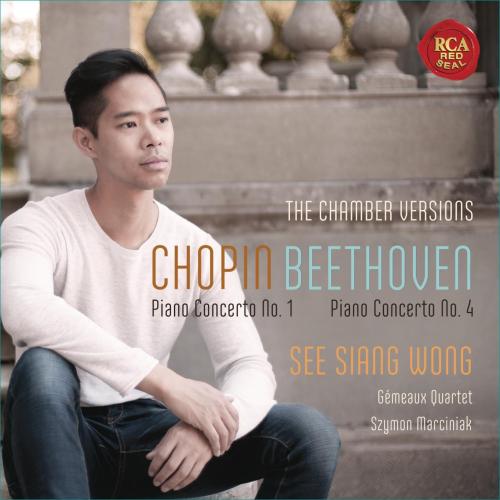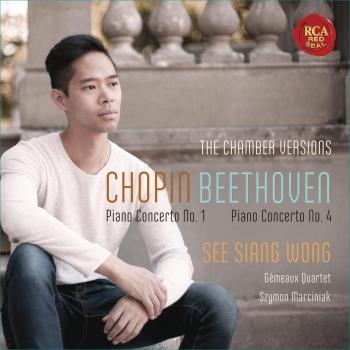
Chopin: Piano Concerto No. 1 & Beethoven: Piano Concerto No. 4 (Chamber Music Versions) See Siang Wong
Album info
Album-Release:
2017
HRA-Release:
20.01.2017
Album including Album cover Booklet (PDF)
I`m sorry!
Dear HIGHRESAUDIO Visitor,
due to territorial constraints and also different releases dates in each country you currently can`t purchase this album. We are updating our release dates twice a week. So, please feel free to check from time-to-time, if the album is available for your country.
We suggest, that you bookmark the album and use our Short List function.
Thank you for your understanding and patience.
Yours sincerely, HIGHRESAUDIO
- Frédéric Chopin (1810 - 1849): Piano Concerto No. 1 in E Minor, Op. 11:
- 1 I. Allegro maestoso 19:32
- 2 II. Romanze. Larghetto 09:22
- 3 III. Rondo. Vivace 10:43
- Ludwig van Beethoven (1770 - 1827): Piano Concerto No. 4 in G Major, Op. 58:
- 4 I. Allegro moderato 17:46
- 5 II. Andante con moto 04:44
- 6 III. Rondo. Vivace 10:04
Info for Chopin: Piano Concerto No. 1 & Beethoven: Piano Concerto No. 4 (Chamber Music Versions)
Chopin and Beethoven: the piano concertos as chamber music. Since the invention of the piano by Bartolomeo Christofori, composers such as Mozart and Haydn have explored and cherished the new tones and dynamic possibilities that the instrument offers. At the beginning of the 19th century, the piano grew increasingly popular and more and more were built and sold. Publishing houses saw an opportunity: they began arranging numerous popular works for piano so amateur musicians could also play them at home. But there was another reason for adapting existing arrangements. Performances of symphonic works were less frequent than today because either suitable musicians or money was lacking. Artists were dependent on patrons; they couldn’t, or didn’t want to, stump up the money themselves. As a result, it was necessary to create smaller versions of large scores so that these works could still be played.
This is probably the case, for example, with Chopin’s piano concerto. Many sources claim that chamber music versions were clearly used for the concerto. Chopin himself wrote that he would often rehearse concertos with smaller chamber music versions, the exact number of musicians remaining open. On September 18, 1830, he wrote to his childhood friend Titus Wojciechowski: “Last Wednesday I rehearsed my concerto with the quartet. But I wasn’t totally happy with it. [...] As to how it turns out with an orchestra, I’ll let you know next week because I’m going to hold a rehearsal on Wednesday. I’ll rehearse it again with the quartet tomorrow.” Some sources also mention an arrangement for a quintet. However, recent research has shown that the term “quartet” was used to refer not only to the traditional line-up of two violins, a viola and a cello, but also as a general term for smaller groups such as chamber orchestras or ensembles that could fit into a parlour. …
See Slang Wong, piano
Gémeaux Quartet:
Yu Zhuang, violin I
Manuel Oswald, violin II
Sylvia Zucker, viola
Matthijs Broersma, violoncello
Szymon Marciniak, double bass
See Siang Wong
Als „feinsinnigen Klangmaler“ bezeichnete die NZZ den Pianisten See Siang Wong, der sich mit persönlichen Interpretationen einen Namen gemacht hat. Bereits als Zwölfjähriger debütierte er mit dem holländischen Rundfunk-Orchester. Seither haben ihn Konzerte an zahlreiche renommierte Häuser in über 30 Länder Europas, Asiens, Amerikas, des Mittleren Ostens sowie nach Australien gebracht (Tonhalle Zürich, KKL Luzern, Concertgebouw Amsterdam, St. Martin in the Fields London, Salle Olivier Messiaen Paris, Marmorsaal Budapest, Philharmonie St.-Petersburg etc.). Er gastiert regelmässig an bekannten internationalen Musikfestivals. Höhepunkte seiner künstlerischen Laufbahn waren Konzerte mit hochkarätigen Dirigenten wie Pierre Boulez, Ralf Weikert und Howard Griffiths.
Seine umfangreiche Diskographie, die von der Fachkritik hochgelobt wurde, ist bei bekannten Labels wie Decca, RCA Red Seal, Sony Classical, Deutsche Harmonia Mundi, Deutsche Grammophon, Novalis erschienen und beinhaltet u.a. Klavierkonzerte und Solowerke von den Bach Söhnen, Beethoven, Chopin, Debussy, Haydn, Mozart, Schubert, Schumann.
See Siang Wongs Interpretation von Schumanns Klavierkonzert war die favorisierte Einspielung der Jury in einem Blindvergleich in der Sendung „Diskothek im 2“ auf Schweizer Radio DRS. Die Solo-Alben mit Werken von Chopin, Haydn, Mozart, Schumann (Decca) und mit Schumanns Klavierkonzert und Beethovens Klavierkonzert Nr. 6 (Novalis) wurden vom Schweizerischen Rundfunk als «Klassik Highlight» gekrönt. 2012 erhielt er den renommierten „Golden Label Award“ der Belgischen Schallplattenkritik.
Sein grosses Interesse für Neue Musik führte zur Zusammenarbeit mit bedeutenden zeitgenössischen Komponisten wie Emmanuel Nunes, Marco Stroppa, James Dillon, Jonathan Harvey und Rudolf Kelterborn. Das Projekt "Swiss Piano" wurde von ihm gegründet und fördert die Kreation von neuen Schweizer Klavierkompositionen; bereits mehr als 30 Werke wurden ihm gewidmet und von ihm uraufgeführt.
Seit 2002 ist er als Dozent an der Zürcher Hochschule der Künste tätig. Von 2006 bis 2008 war er Gastdozent an der Musikhochschule Luzern. Er gibt Meisterkurse im In- und Ausland.
See Siang Wong studierte in Holland bei Marjès Benoist und in der Schweiz bei Homero Francesch und Bruno Canino. Er gehört zum exklusiven Kreis der Steinway & Sons-Künstler und lebt heute in der Schweiz.
Booklet for Chopin: Piano Concerto No. 1 & Beethoven: Piano Concerto No. 4 (Chamber Music Versions)











